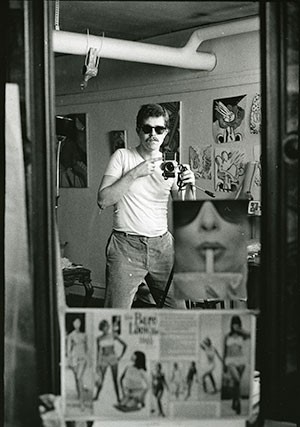Born 1938, Pittsfield, Massachusetts
The fine draftsmanship and outlandish figures in Jim Nutt’s paintings conjure the sinuous lines and graphic distortions of American comic strips and Weimar-era caricatures by George Grosz and Max Beckmann. Nutt’s visual interests embrace these and many other sources, including self-taught art, surrealism, film noir, and northern Renaissance painting. His disregard for traditional distinctions between high and low art was nurtured in the early 1960s at the School of the Art Institute of Chicago, where faculty members Whitney Halstead and Ray Yoshida advanced an expansive art history that included non-Western, folk, and vernacular art forms alongside the Western canon. Nutt first exhibited his work in the late 1960s with several Art Institute classmates, including his wife, Gladys Nilsson, under the moniker “Hairy Who.” His paintings from this period are marked by bright, saturated hues and an even sheen that resulted from his technique of applying acrylic paint to the reverse side of Plexiglas. A culminating work in this vein, Toot-Toot Woo-Woo, portrays a maimed figure catapulted through an acid green sky, with comic-style motion lines tracing her forceful trajectory. Around her, tiny objects scatter through the air and onto the wooden frame, which Nutt treats as part of the composition.
In the 1970s Nutt began painting on metal, wood, canvas, and paper in a more muted palette, but with richer textural and tonal variations. In contrast to the flatness of his early works, subsequent paintings arrange figural groups in deeper architectural spaces and theatrical prosceniums. It Shouldn’t Happen This Way! (Oh Yeah?) features a neoclassical marble niche opening onto an area beyond, where a Greco-Roman maiden rendered with Botticelliesque serpentine lines and Picassoid bulbous protrusions flees a tiny, cartoonish male and a grimacing cowboy. The elaborate framing emphasizes the passage into a self-contained, alternate reality of Nutt’s invention. His commitment to developing his own visual world rather than following art market trends was strengthened when he discovered the work of untrained yet exceptionally inventive artists working outside of mainstream art channels, in particular Joseph Yoakum and Martín Ramírez. The intimate, imaginary portraits Nutt has developed since the 1980s concentrate and hone his investigation of unconventional physiognomy and individual expression.
Antonia Pocock
Halstead, Whitney. Jim Nutt. Chicago: Museum of Contemporary Art, 1974.
Jim Nutt. Milwaukee: Milwaukee Art Museum, 1994.
Warren, Lynne. Jim Nutt: Coming into Character. Chicago: Museum of Contemporary Art, with Yale University Press, New Haven, 2011.
